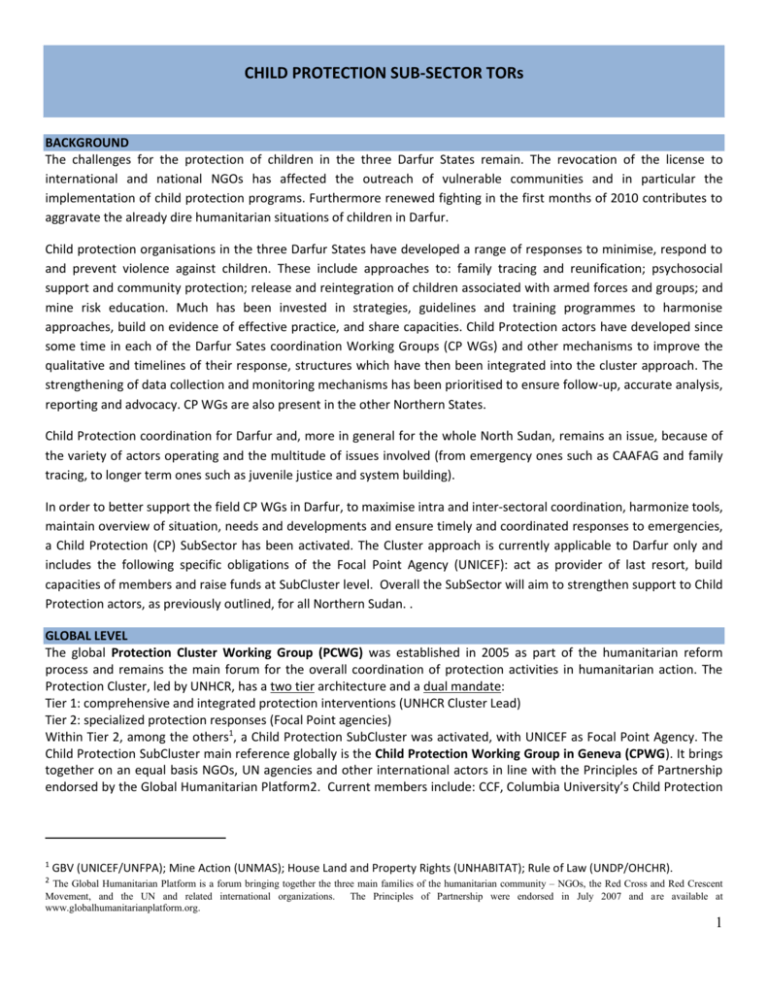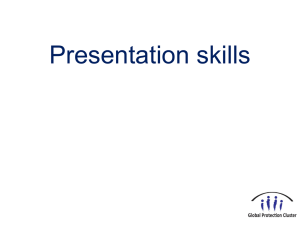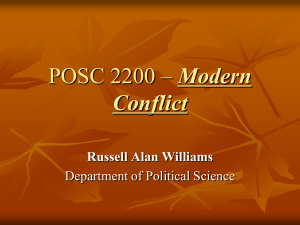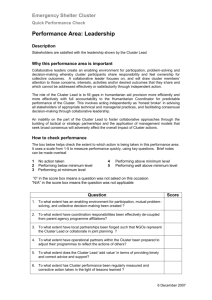Sudan CP Sub-Cluster TOR 2010 ENG
advertisement

CHILD PROTECTION SUB-SECTOR TORs BACKGROUND The challenges for the protection of children in the three Darfur States remain. The revocation of the license to international and national NGOs has affected the outreach of vulnerable communities and in particular the implementation of child protection programs. Furthermore renewed fighting in the first months of 2010 contributes to aggravate the already dire humanitarian situations of children in Darfur. Child protection organisations in the three Darfur States have developed a range of responses to minimise, respond to and prevent violence against children. These include approaches to: family tracing and reunification; psychosocial support and community protection; release and reintegration of children associated with armed forces and groups; and mine risk education. Much has been invested in strategies, guidelines and training programmes to harmonise approaches, build on evidence of effective practice, and share capacities. Child Protection actors have developed since some time in each of the Darfur Sates coordination Working Groups (CP WGs) and other mechanisms to improve the qualitative and timelines of their response, structures which have then been integrated into the cluster approach. The strengthening of data collection and monitoring mechanisms has been prioritised to ensure follow-up, accurate analysis, reporting and advocacy. CP WGs are also present in the other Northern States. Child Protection coordination for Darfur and, more in general for the whole North Sudan, remains an issue, because of the variety of actors operating and the multitude of issues involved (from emergency ones such as CAAFAG and family tracing, to longer term ones such as juvenile justice and system building). In order to better support the field CP WGs in Darfur, to maximise intra and inter-sectoral coordination, harmonize tools, maintain overview of situation, needs and developments and ensure timely and coordinated responses to emergencies, a Child Protection (CP) SubSector has been activated. The Cluster approach is currently applicable to Darfur only and includes the following specific obligations of the Focal Point Agency (UNICEF): act as provider of last resort, build capacities of members and raise funds at SubCluster level. Overall the SubSector will aim to strengthen support to Child Protection actors, as previously outlined, for all Northern Sudan. . GLOBAL LEVEL The global Protection Cluster Working Group (PCWG) was established in 2005 as part of the humanitarian reform process and remains the main forum for the overall coordination of protection activities in humanitarian action. The Protection Cluster, led by UNHCR, has a two tier architecture and a dual mandate: Tier 1: comprehensive and integrated protection interventions (UNHCR Cluster Lead) Tier 2: specialized protection responses (Focal Point agencies) Within Tier 2, among the others1, a Child Protection SubCluster was activated, with UNICEF as Focal Point Agency. The Child Protection SubCluster main reference globally is the Child Protection Working Group in Geneva (CPWG). It brings together on an equal basis NGOs, UN agencies and other international actors in line with the Principles of Partnership endorsed by the Global Humanitarian Platform2. Current members include: CCF, Columbia University’s Child Protection 1 GBV (UNICEF/UNFPA); Mine Action (UNMAS); House Land and Property Rights (UNHABITAT); Rule of Law (UNDP/OHCHR). 2 The Global Humanitarian Platform is a forum bringing together the three main families of the humanitarian community – NGOs, the Red Cross and Red Crescent Movement, and the UN and related international organizations. The Principles of Partnership were endorsed in July 2007 and are available at www.globalhumanitarianplatform.org. 1 Learning Network, International Rescue Committee, Save the Children Alliance, Terre des hommes, Women’s Commission, World Vision, OCHA, UNHCR and UNICEF. ICRC also supports the CPWG as an observer. The Child Protection WG is supporting CP Subclusters at the country level in various ways: policy and standards setting, capacity building, advocacy, fundraising etc.3 SUDAN The protection lead agency role (whether under sector or cluster) has been divided between UNHCR and UNMIS POC according to presence and capacity. Therefore at national level, UNMIS POC and UNHCR are co-leads. In Darfur, Khartoum region and the east UNHCR is the lead; in the Transitional Areas UNMIS POC is the lead. UNICEF assumes the lead role (Focal Point Agency) on child protection. Several protection forums are currently in place at different levels in Northern Sudan, in which UNHCR represents protection issues, assisted by UNICEF on child protection specific concerns: Darfur level: Darfur Inter-sector Coordination Team (‘D/ISCT’) – Darfur Protection Cluster plus now CP SubSector– Human Rights Forum – IMWG State level: Protection Cluster WGs – CP WGs – GBV WGs – Returns WGs; A/HCT and A/InterSector Coordination Team (‘A/ISCT’) UNICEF, as Focal Point for child protection, will take all necessary actions to ensure fulfillment of commonly accepted standards for timely, adequate and effective humanitarian action that achieves the required impact in relation to the specific Sub-Cluster area and in line with the Convention on the Rights of the Child, its additional Protocols, the Core Commitments for Children in Emergencies (CCCs) and the African Charter on the Rights and Welfare of the Child. As a Focal Point agency UNICEF will ensure that child protection are mainstreamed into other clusters’ work and at the appropriate level (ISCT, HCT etc), as well as act as “provider of last resort” within the Cluster system (currently applicable to Darfur only). Coordination with the Government of Sudan /Local Authorities A key responsibility of the Child Protection SubSector is to ensure that humanitarian actors build on local capacities and that they develop and maintain appropriate links with Government and local authorities, state institutions, local civil society and other stakeholders. The approach does not diminish the responsibility of the State, first and foremost to take care of the victims of conflict and other emergencies occurring on its territory. The affected State has the primary role in the initiation, organization, coordination, and implementation of humanitarian assistance (GA Resolution 46/182). The approach does not imply that the SubSector lead is responsible for leading the overall humanitarian response within the Child Protection sector, as this may be the responsibility of a government department or a local authority. MISSION STATEMENT The Child Protection SubSector is a forum that aims to support a more predictable, accountable and effective child protection response to chronic and sudden onset emergencies, with the ultimate objective of creating a comprehensive protective environment for all children living in Sudan. Role of Child Protection Sub-Sector Lead As a SubSector lead, UNICEF will ensure that needs assessments and responses are based on participatory and community based approaches which integrate cross cutting issues, ensuring effective links with other clusters, monitoring and adjustment of the response, and acting as the provider of last resort. 3 CP WG work plan may be found at http://oneresponse.info/GlobalClusters/Protection/CP/Pages/default.aspx 2 The Child Protection SubSector recognizes that the protection of all persons affected by the conflict, and by any other emergency may occur, is the primary responsibility of the Government of Sudan. The SubSector aims therefore at building a sound partnership with all governmental structures mandated to create a protective environment for children. It also recognizes that civil society, including NGOs and religious organizations as well as community members, play an important role in strengthening the protection of the affected population. The aim of the Child Protection Sub Cluster is to strengthen and build upon existing protection mechanisms. The SubSector Lead is ultimately accountable to the Protection Cluster Lead and to the Humanitarian Coordinator. Deputy Lead The SubSector lead will be supported by a Deputy (possibly an NGO) to be selected by the members on a rotational basis (every 6 months). The Deputy will in particular assist the Lead on: ensure representation at meetings; consolidating reports and inputs from members; promote information sharing and liaise with counterparts in the field; report to the Protection Cluster and other relevant forums in absence of the Lead. Membership: The members of the SubSector should be organizations engaged on child protection activities in North Sudan (including Transitional Areas). All the members agree to apply the Principles of Partnership (Equality, Transparency, Results Oriented, Responsibility and Complementarity) as set out in Annex 1. While the Cluster approach does not consider cluster participants accountable to the Lead Agency, by taking part to the CP SubSector members agree to: - Endorse the overall aim and objectives of the CP SubSector - Be proactive in exchanging information, highlighting needs and gaps, reporting progress and learning, mobilizing resources, engaging with affected communities applying the humanitarian principles and to commit to build local capacities - Share responsibilities within the SubSector including assessing needs, developing plans, policies and guidelines in line with agreed priorities and work plan - Respect and adhere to agreed policies, priorities and standards. Frequency and reporting The CP SubSector will meet every four to six weeks in Khartoum or elsewhere (it is foreseen that meetings will be organized in the three Darfur capitals on a rotational basis). Ad hoc meetings can be called at short notice in case of onset crises or specific purposes (e.g. finalization of SubSector’s documents for upcoming events). The SubSector Lead will report to the Protection Cluster Lead and D/HC on its activities as requested. OBJECTIVES of the Child Protection SubSector 1. To ensure the inclusion of key humanitarian partners and partnership with civil society and Government 2. To establish and maintain appropriate humanitarian coordination mechanisms and represent the cluster to appropriate forums 3. To foster participatory and community-based approaches 4. To include priority cross-cutting issues in planning and responses 5. To ensure needs assessment and analysis are carried out in time of emergencies and reflect emerging issues 6. To strengthen emergency preparedness capacities 7. To plan and develop strategies and policies 8. To design standards whereas needed and ensure their application 9. To guarantee CP monitoring and reporting 10. To develop and disseminate CP specific advocacy messages and enhance resource mobilization and allocations for the Subsector 11. To build capacities of members and main counterparts 3 12. To ensure that members and Lead are engaged in providing timely responses to crises TASKS of the Child Protection SubSector 1. Inclusion of key humanitarian partners and partnership with civil society and Government: Ensure identification and inclusion of key Child Protection humanitarian partners in a way that respects their mandates and program priorities; Act as focal point for inquiries on the Child Protection Cluster’s response plans and operations ; Guarantee that CP Subsectoral Coordination is done in a way that is in support to the Government existing structures and promote Government Leadership and identify appropriate mechanisms to collaborate with the relevant national authorities; Ensure that Child Protection humanitarian responses build on local capacities; Create appropriate links with civil society and other relevant actors (e.g. child protection networks, religious leaders etc). 2. Management and representational responsibilities: Ensure appropriate coordination between all Child Protection humanitarian partners (national and international NGOs, Donor Community etc…), through establishment/maintenance of appropriate Child Protection Sub Cluster coordination mechanisms (SubSector and State WGs), including thematic working groups at the national and sub national levels where needed; Represent the interests of the Child Protection SubSector within the Protection Cluster as well as within the OCHA-led InterCluster coordination mechanisms, HCT and other relevant forums and wherever needed and with UNHCR’s support, raise CP concerns at the HC/DHC level; Secure commitments from Child Protection humanitarian partners in responding to needs and filling gaps, ensuring an appropriate distribution of responsibilities within the Child Protection group, with clearly defined focal points for specific issues where necessary; Establish results oriented two-way communication channels between national and sub-national levels (WGs) to promote, upgrade and strengthen a more standardized CP response. Ultimate product being an interagency CP Action plan (including programs and advocacy); Ensure the complementarity of different Child Protection humanitarian actors’ actions; Promote Child Protection emergency response actions while at the same time considering Child Protection within early recovery planning and identify where possible entry points for building national child protection systems; Ensure effective continuous linkages with other Clusters and groups (e.g. MHPSS); Ensure that Child Protection coordination mechanisms are adapted over time to reflect the capacities of local actors and the engagement of development partners; Maintain information on all current and potential Child Protection partners, their capacities and areas of work (including Who, What, Where and by When) jointly with the Protection Cluster. 3. Participatory and community-based approaches: 4 Ensure utilization of participatory and community based approaches in Child Protection related assessments, analysis, planning, monitoring and response; Foster children’s participation in SubSector /WGs work and in particular in the design of tools. 4. Attention to priority cross-cutting issues: Work with child protection actors and other to promote the integration of cross cutting issues into child protection planning and response (e.g. HIV/IADS, environment, gender, rights based approach etc) 5. Needs assessment and analysis: Promote and supervise inter-agency child protection needs assessment to map out priority gaps and identify key resources and assets; Design and promote the use of harmonized protection and child protection assessment formats; Work with UNHCR to ensure that CP concerns are reflected into protection or inter-sectoral assessments, as well as other sectoral non-CP ones and promote inter-cluster assessments. 6. Emergency preparedness: Ensure adequate Child Protection related contingency planning and preparedness for potential significant changes in the nature of the current situation; Mainstream CP issues into current and future national and sub-national contingency plans. 7. Planning and strategy development: Ensure predictable Child Protection action within the cluster group for the following: Identification of gaps in the field of Child Protection and conceptualization of how cluster needs can be met through collective delivery. Designing of a CP Strategy / Action plan fully in line with the overall Protection Cluster ones; Ensure that Strategy / Action Plan are adequately reflected in the overall country strategies, such as the Common Humanitarian Action Plan (CHAP) and the CHF guidelines; Drawing lessons learned from past Child Protection activities and revising strategies and action plans accordingly; Developing an exit, or transition strategy for Child Protection interventions and key cluster partners, with clear focus on system building. 8. Application of standards: Ensure that Child Protection sector participants are aware of relevant policy guidelines, technical standards and relevant commitments that the Government has undertaken under international law; Ensure that Child Protection responses are in line with Sudan existing policy guidance, technical standards, and relevant Government international obligations; Work with partners to promote and integrate the “do no harm” principle in their CP response. 5 9. Monitoring and reporting: Ensure adequate monitoring mechanisms are in place to review impact of Child Protection interventions and progress against implementation plans. Drafting of an harmonized list of CP indicators, benchmarks and monitoring system; Ensure adequate Child Protection impact reporting and effective information sharing (with OCHA support) with attention to sex, age and vulnerability types disaggregation. 10. Advocacy, resource mobilization and allocation: Identify core Child Protection advocacy concerns, including resource requirements, and contribute key messages to broader advocacy initiatives of the HC, UNICEF and other actors; Develop ad hoc CP advocacy messages (SubSector Lead directly or through Protection Cluster to act as spokesperson); Support CP actors in the development of joint CHF, CERF, FLASH and CAP proposals; Advocate for donors to fund Child Protection actors to carry out priority Child Protection activities in the cluster (and organize ad hoc meetings with donors), while at the same time encouraging Child Protection actors to mobilize resources for their activities through their usual channels; Establish mechanisms for financial resource allocation at Sector level for both pooled funded projects and those funded through the Cluster lead. 11. Training and capacity building: Develop a capacity building strategy for SubSector members and their partners, with related fund raising needed; Support efforts to strengthen the Child Protection capacity of the national/sate authorities and civil society including community structures; Disseminate capacity building opportunities available globally (in particular through the CPWG in Geneva) and locally. 12. Provision of timely responses to crises : Where critical gaps in addressing Child Protection priorities are identified the Emergency Child Protection SubSector Lead will: Lobby for humanitarian partners to address the gaps; With advice/support from the Protection Cluster and support from other humanitarian partners will advocate, as appropriate, on the adequate provision of resources and safe access; Provider of last resort (applicable to the cluster approach only – Darfur): if persistent gaps remain then with the full support of the UNICEF Representative, specifically request that UNICEF Child Protection Section takes action to fill the critical gaps through direct implementation. 6 ANNEX 1 7 8








